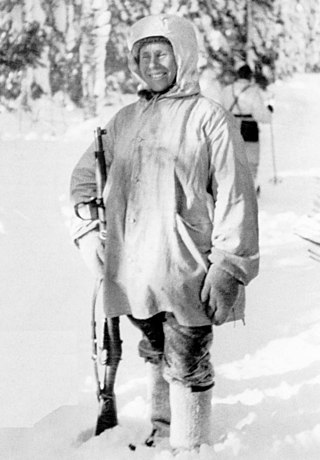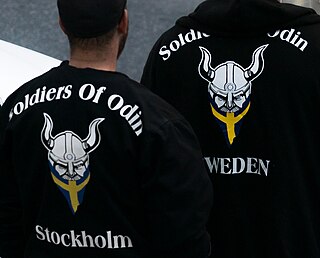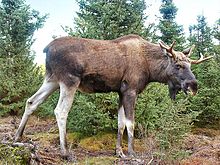
The moose or elk is the world's tallest, largest and heaviest extant species of deer and the only species in the genus Alces. It is also the tallest, and the second-largest, land animal in North America, falling short only of the American bison in body mass. Most adult male moose have broad, palmate antlers; other members of the deer family have pointed antlers with a dendritic ("twig-like") configuration. Moose inhabit the circumpolar boreal forests or temperate broadleaf and mixed forests of the Northern Hemisphere, thriving in cooler, temperate areas as well as subarctic climates.
The National Coalition Party is a liberal-conservative political party in Finland.

Matti Taneli Vanhanen is a Finnish politician who served as Prime Minister of Finland from 2003 to 2010. He was also Chairman of the Centre Party in 2006. In his earlier career, he was a journalist. Vanhanen is the son of professor Tatu Vanhanen and Anni Tiihonen.

The Finns Party, formerly known as the True Finns, is a right-wing populist political party in Finland. It was founded in 1995 following the dissolution of the Finnish Rural Party. The party is currently a participant in the Government of Petteri Orpo, holding seven ministerial portfolios. The party achieved its electoral breakthrough in the 2011 Finnish parliamentary election, when it won 19.1% of votes, becoming the third largest party in the Parliament of Finland. In the 2015 election the party got 17.7% of the votes, making it the parliament's second-largest political party. The party was in opposition for the first 20 years of its existence. In 2015, it joined the coalition government formed by Prime Minister Juha Sipilä. Following a 2017 split, over half of the party's MPs left the parliamentary group and were subsequently expelled from their party membership. This defector group, Blue Reform, continued to support the government coalition, while the Finns Party went into opposition. The party, having been reduced to 17 seats after the split, increased its representation to 39 seats in the 2019 Finnish parliamentary election, while Blue Reform failed to win any seats. During the 2023 Finnish parliamentary election, the Finns Party finished in second place and recorded their strongest result, 46 seats, since the party's founding.

Simo Häyhä, often referred to by his nickname, The White Death, was a Finnish military sniper in World War II during the 1939–1940 Winter War against the Soviet Union. He used a Finnish-produced M/28-30 and a Suomi KP/-31 submachine gun. He is believed to have killed over 500 enemy soldiers during the Winter War, the highest number of sniper kills in any major war. Because of this, he is often regarded as the deadliest sniper of all time.

The Finnish Security and Intelligence Service, formerly the Finnish Security Police and Finnish Security Intelligence Service, is the security and intelligence agency of Finland in charge of national security, such as counter-intelligence and counter-terrorism, under the jurisdiction of the Ministry of the Interior. The agency had a distinct role during the Cold War in monitoring communists as well as in the balance between Finnish independence and Soviet appeasement. After the 1990s, Supo has focused more on countering terrorism and in the 2010s, on preventing hybrid operations.

Kostroma Moose Farm is an experimental farm in Kostroma Oblast, Russia, where a herd of moose is kept, primarily for milk production; the farm supplies moose's milk to a nearby sanitorium. It is located near the village of Sumarokovo in Krasnoselsky District of Kostroma Oblast, some 25 km east of the city of Kostroma.

The Finnish Defence Intelligence Agency is the combined signals (SIGINT), geospatial (GEOINT) and imagery intelligence (IMINT) agency of the Finnish Defence Forces. Operational since 2014, its responsibility is to support the defence of Finland through information gathering and analysis as an intelligence agency, organic to the Intelligence Division of Defence Command.

Immigration to Finland is the process by which people migrate to Finland to reside in the country. Some, but not all, become Finnish citizens. Immigration has been a major source of population growth and cultural change throughout much of the history of Finland. The economic, social, and political aspects of immigration have caused controversy regarding ethnicity, economic benefits, jobs for non-immigrants, settlement patterns, impact on upward social mobility, crime, and voting behaviour.
Anton Salonen is a child with Russian-Finnish dual citizenship involved in an international child custody dispute between his parents. The Finnish-born child was first abducted by his Estonian Russian mother in 2008 and taken to Russia. In turn the boy was abducted by his father in 2009 and smuggled back to Finland with the help of Finnish diplomats stationed at the Finnish consulate in Saint Petersburg. The incident has sparked a diplomatic row between Finland and Russia. The Finnish diplomat who helped to abduct the child was dismissed from the Finnish Consulate and Russia has declared him persona non grata.

Presidential elections were held in Finland in January and February 2012. The first round took place on 22 January 2012 with advance voting between 11 and 17 January. Since no candidate received a majority of the vote, a second round was held on 5 February, with advance voting between 25 and 31 January. Sauli Niinistö was elected the President of Finland for a term from 1 March 2012 until 1 March 2018.

The Social Democratic Party of Finland is a social democratic and pro-European political party in Finland. It is the third largest party in the Parliament of Finland with 43 seats. Founded in 1899 as the Workers' Party of Finland, the SDP is Finland's oldest active political party and has a close relationship with the Central Organisation of Finnish Trade Unions. It is also a member of the Party of European Socialists, Progressive Alliance, Socialist International and SAMAK.

Finnish art started to form its individual characteristics in the 19th century, when romantic nationalism began to rise in the autonomous Grand Duchy of Finland.

Soldiers of Odin is an anti-immigrant group which was founded in Kemi, Finland, in October 2015. The group was established in response to the thousands of migrants who were arriving in Finland amidst the European migrant crisis. They call themselves a "patriotic organisation that fights for a Finland" that wants to scare away "Islamist intruders" they say cause insecurity and increase crime.

Sanna Mirella Marin is a Finnish former politician who served as prime minister of Finland from 2019 to 2023 and as the leader of the Social Democratic Party of Finland (SDP) from 2020 to 2023. She was a Member of Parliament from 2015 to 2023. She was re-elected as member of parliament in April 2023 but resigned from her position in the Finnish parliament to become a strategic adviser on political leaders' reform programmes in the Tony Blair Institute in September 2023.

Parliamentary elections were held in Finland on 2 April 2023 to elect members of the Parliament of Finland.
The COVID-19 pandemic in Finland has resulted in 1,499,712 confirmed cases of COVID-19 and 11,466 deaths.

In Finland, the far right was strongest in 1920–1940 when the Academic Karelia Society, Lapua Movement, Patriotic People's Movement (IKL) and Vientirauha operated in the country and had hundreds of thousands of members. In addition to these dominant far-right and fascist organizations, smaller Nazi parties operated as well.
Janus Kostia Putkonen is a Finnish theater director, journalist, eurosceptic and propagandist. Putkonen was the editor-in-chief of the Verkkomedia website, which was active from 2011–2013. From 2015 to 2018, he was the director of the Russian-backed Donetsk Separatist Information Center Doni-News. Since 2019, he has been the editor-in-chief of MV-media. Putkonen focused Russian funded Doni-news and MV-media to support pro-Russian propaganda about the Donetsk People's Republic.

The Consulate of the Russian Federation in Åland is a Russian diplomatic mission in Finland's autonomous Åland region. The consulate is located in Åland's capital, Mariehamn, and is subordinate to the Russian Embassy in Helsinki. The current consul is Alexander Rogov.
















